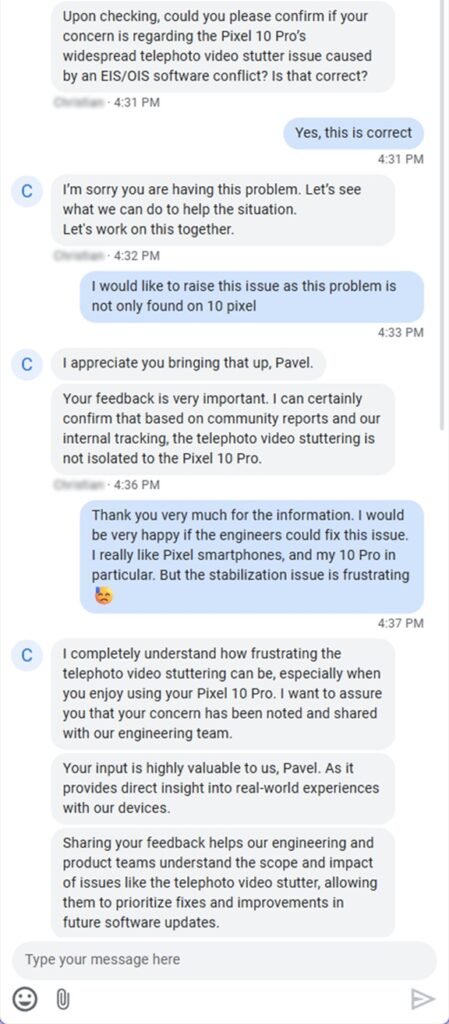For years, Pixel fans have had one persistent complaint: Google’s otherwise brilliant camera software occasionally turns into its own worst enemy. And now, thanks to a determined Pixel 10 Pro owner’s investigation, it looks like Google has quietly admitted that the long-standing video stutter bug might finally have a name and an explanation.
A problem that’s been hiding in plain sight
A Pixel 10 Pro owner noticed something odd while filming with the 5x telephoto lens. Every time they panned the camera, the video would stutter sharply as if the footage was skipping frames or “jumping.” At first glance, it looked like a hardware defect, but further testing revealed something else entirely.
The issue, as the Redditor later confirmed, happens specifically when Electronic Image Stabilization (EIS) is turned on. Disable EIS, and the Optical Image Stabilization (OIS) works perfectly fine. But when both systems try to work together, they clash, resulting in those abrupt, unnatural jumps in the video.
Even more revealing: the same behavior was spotted on multiple Pixel generations, from older models to the latest Pixel 10 and 10 Pro. This isn’t an isolated case or a bad unit. It is a pattern.
Google support finally confirms what many suspected
After weeks of testing, video evidence, and community discussions, the Redditor decided to take the matter directly to Google. In a live chat with Pixel Support, a screenshot of which was shared on Reddit, and we have it below, a Google agent officially acknowledged the existence of the “Pixel 10 Pro’s widespread telephoto video stutter issue caused by an EIS/OIS software conflict.”

Even more notably, the agent added that the issue was “not isolated to the Pixel 10 Pro,” confirming that internal tracking and community reports pointed to the same conclusion.
It’s not every day that Google admits to a camera bug, especially one this specific. For many in the Pixel community, this acknowledgment feels like a small but meaningful victory after years of quietly battling with video jitter.
Open Camera, a free app, rather proves it’s a software bug
The turning point in this investigation came when a fellow Redditor suggested trying a free app called Open Camera, one that uses its own camera stabilization API instead of Google’s.
The result? Instant clarity. Using Open Camera’s API completely eliminated the stutter on the telephoto lens. Smooth pans. No jumps. No jitter. The hardware was clearly fine, which meant the real culprit was Google’s own EIS implementation. Check out the comparison video below:
As the Redditor put it:
“This is the definitive proof we needed. The hardware is fine. The problem is, and has always been, Google’s broken software.”
A multi-generational, software-level bug
The investigation, now spanning a couple of detailed Reddit posts, YouTube breakdowns, X posts, and even a coordinated bug report campaign, paints a clear picture: this is a multi-generational software problem that affects how Google’s real-time EIS algorithm interacts with OIS across the entire Pixel camera lineup.
The theory is that Google’s EIS is too aggressive, moving the digital crop too violently during stabilization. When it reaches the crop boundary, it “snaps” or “jumps,” creating that harsh stutter effect. On telephoto lenses, this aggressive movement clashes directly with OIS hardware corrections, amplifying the problem.
The Redditor later confirmed that Google support officially opened a case file, now marked “In Progress”, after receiving their detailed investigation report with logs and video evidence.

The temporary fix and a long-term hope
For now, users have found a workaround:
- Turn off EIS when shooting telephoto video (letting OIS handle stabilization), or
- Use the Open Camera app, which bypasses the buggy Pixel API entirely.
Those looking for ultra-smooth results can still use Video Boost, which processes clips in the cloud and returns perfectly stabilized footage, though it’s more of a patch than a fix. You can also use Google Photos to handle the post-processing, which some users say is perfectly fine.
Pixel phones have built their reputation on computational photography, the idea that smart software can outperform raw hardware. But this saga shows the other side of that coin: when the software misbehaves, even world-class hardware can stumble. Still, the fact that Google’s support team has now acknowledged the “EIS/OIS software conflict” behind the scenes marks an important turning point. For the first time, there’s an official thread connecting user frustration, community investigation, and company awareness.
If Google acts on this feedback in future updates, it could finally put to rest one of the Pixel camera’s most nagging video recording flaws.

